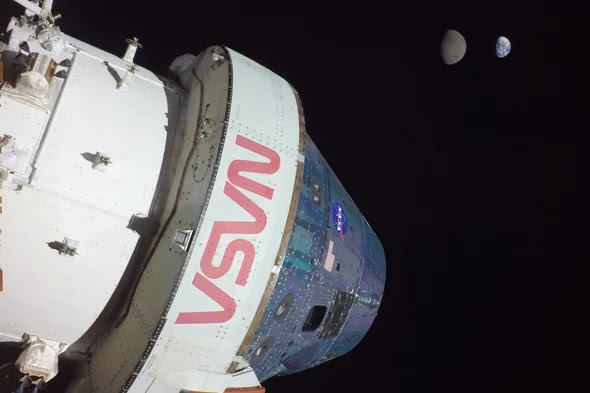On November 16, just after 1:45 A.M. ET, NASA's orange-hued SLS rocket ignited and blazed into the sky, lighting up Florida's Space Coast. The launch was a success because it was the biggest rocket that humans had ever launched into space and it was the first time in 50 years that a crew-rated spacecraft would travel close to the moon. These achievements followed lengthy testing and development delays, during which time costs skyrocketed. They also came after months of frustrating passivity on the launchpad, during which previous flight attempts had been aborted due to fuel leaks, as well as numerous hurricanes.
But after that rocky beginning, things got easier. Orion was successfully placed in orbit by the SLS. The spacecraft successfully completed a crucial 20-minute engine burn as it set itself on a course for the moon. The engines fired repeatedly as they flew, once to enter and once to exit lunar orbit, and once to return to Earth. Mission managers only noticed a few minor occurrences along the way that they dubbed "funnies," which are unexpected things that aren't necessarily problems. No significant onboard anomalies were found.
The first weekend in December, when the Goldstone radio telescope, the foundation of NASA's Deep Space Network, went offline and cut off communication with the spacecraft for several hours, may have been the mission's most serious ground-based issue. Shockwaves and exhaust plumes pounded the mobile launch structure and blew the doors off the elevators as the SLS blasted off the launch pad, causing additional unanticipated damage to the launch facility at Kennedy Space Center. The mission went so smoothly that managers felt secure enough to perform additional, in-flight tests of the spacecraft's capability as the mission went on. Finally, everything came together.
On the 25th flight day of NASA's Artemis I mission, an unmanned Orion spacecraft travelled to and from the moon. According to a NASA update, Orion was cruising at 2,813 mph and was then 136,597 miles from Earth and 232,127 miles from the moon. In its fifth burn of the return trajectory, Orion's service module fired its engine to adjust its approach for splashdown the following day.
The Orion capsule continued its second phase of re-entry after the raising and atmospheric skip burns were carried out successfully. Approximately 4 minutes of radio silence followed the re-entry. The re-entry speed was Mach 32 (24,500 mph or 39428.928 km/hr), according to NASA's Artemis I live update website.
 Fig: A view out the window of Orion during re-entry of Artemis 1 on Dec. 11, 2022. (Image credit: NASA Television)
Fig: A view out the window of Orion during re-entry of Artemis 1 on Dec. 11, 2022. (Image credit: NASA Television)Then, various kinds of parachutes were released, including:
1. As the Artemis I nears the end of its life, it deployed its 11 parachutes in several rounds to slow down for splashdown and
2. its primary parachutes for the moment of splashdown.
Fig: At final moment of splashdown(Credit: NASA TV)
On December 11, in the late afternoon, an unmanned Orion capsule splashed down in the Pacific Ocean off the coast of Baja California, successfully ending NASA's historic Artemis I moon mission after a 1.4 million-mile (2.3 million-kilometers) flight. The splashdown happened on the same day, fifty years ago, as NASA's Apollo 17 moon landing, which was the final astronaut mission to set foot on the moon.
2. Success Analysis
Although Artemis I successfully accomplished its primary goal of showcasing Orion's functionality in deep space and returned the spacecraft to Earth, some of the secondary tasks yielded decidedly inconsistent results. Ten CubeSats, or shoebox-sized science experiments, were carried by the spacecraft as it launched into orbit. To study the moon's ice and other surface features, some of these were directed toward the moon. Others were sent to keep an eye on the environment in space. One of them, NASA's NEA Scout, was even planned for a close encounter with an asteroid.
About half of those 10 CubeSats performed as expected. It's unclear whether the issues with the other experiments are related to their prolonged stay on the rocket—as some of them were loaded onto the SLS more than a year ago—or to the difficulty of designing a small satellite to function in deep space.
- Since NEA Scout hasn't made contact with the earth and its crew isn't even sure if the spacecraft has ever been powered on, it is assumed to be lost.
- OMOTENASHI, a Japanese CubeSat, was designed to launch a tiny lunar lander, but after deployment it spun out of control and stopped further operations.
- Another NASA CubeSat, LunaH-Map, failed to carry out a crucial propulsion manoeuvre and will not be able to map the ice deposits near the moon's south pole unless the LunaH-Map team can quickly restart its propulsion system.
Fig: The CubeSat missions were nestled in the SLS stage adapter ring prior to launch(Credit: NASA)
3. Conclusion
Despite that hiccup, Artemis I performed significantly better than the Apollo program's equivalent mission, 1968's Apollo 6, which was very nearly a failure. Apollo 6 was the final unmanned test flight for the Saturn V rocket and Apollo spacecraft. The Orion spacecraft's heat shield has proven that it can withstand heat as intense as the sun's surface. The SLS's ability to lift large payloads is also put to the test, and it has now been officially confirmed that it will be able to transport people back and forth in 2024. We can therefore affirm that the Artemis I mission is the replacement for the Apollo Mission, which was carried out in the 1960s–1970s.










1 Comments
Hope one day atleast one or more person will read this and find this interesting... Goodluck to all if anyone discovers it.
ReplyDelete